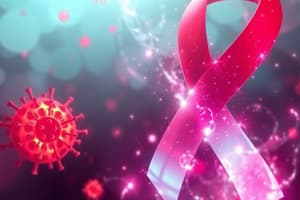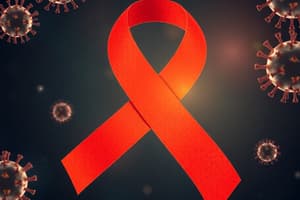Podcast
Questions and Answers
How does chronic inflammation due to HIV contribute to the development of non-AIDS-defining conditions?
How does chronic inflammation due to HIV contribute to the development of non-AIDS-defining conditions?
- By accelerating the aging process of cells, leading to organ dysfunction.
- By fostering the development of cardiovascular, liver, and neurocognitive diseases. (correct)
- By promoting the activation of latent viral infections in various organs.
- By directly attacking and destroying specific organ tissues.
What is the primary impact of continuous immune activation and viral replication on immune cells in HIV?
What is the primary impact of continuous immune activation and viral replication on immune cells in HIV?
- Reduced susceptibility to apoptosis, leading to immune cell accumulation.
- Increased proliferation and differentiation into specialized immune cells.
- Exhaustion, compromising the body’s ability to combat infections and malignancies. (correct)
- Enhanced production of antibodies and cytokines for improved immune response.
What immunological event defines the progression from HIV infection to AIDS?
What immunological event defines the progression from HIV infection to AIDS?
- A profound depletion of CD4+ T cells, severely compromising the immune system. (correct)
- The development of antibodies that neutralize a broad spectrum of HIV variants.
- A sudden surge in CD8+ T cell counts, indicating a robust cytotoxic response.
- A significant increase in the body's production of interferon, enhancing antiviral defenses.
What is the ultimate consequence of the cumulative effects of chronic HIV infection, inflammation, and opportunistic diseases on the body?
What is the ultimate consequence of the cumulative effects of chronic HIV infection, inflammation, and opportunistic diseases on the body?
In the absence of effective antiretroviral therapy (ART), what is the typical outcome of HIV infection?
In the absence of effective antiretroviral therapy (ART), what is the typical outcome of HIV infection?
Which cellular process is directly responsible for the creation of a DNA copy of the HIV RNA genome within an infected cell?
Which cellular process is directly responsible for the creation of a DNA copy of the HIV RNA genome within an infected cell?
How does HIV primarily gain entry into host cells such as CD4+ T cells?
How does HIV primarily gain entry into host cells such as CD4+ T cells?
What is the primary consequence of the depletion of CD4+ T cells in individuals infected with HIV?
What is the primary consequence of the depletion of CD4+ T cells in individuals infected with HIV?
What defines the progression from HIV infection to AIDS?
What defines the progression from HIV infection to AIDS?
During HIV replication, what is the role of the viral enzyme integrase?
During HIV replication, what is the role of the viral enzyme integrase?
Chronic immune activation is a significant aspect of HIV pathophysiology. What is the primary result of this activation?
Chronic immune activation is a significant aspect of HIV pathophysiology. What is the primary result of this activation?
Which of the following is NOT a typical target cell for HIV during the initial stages of infection?
Which of the following is NOT a typical target cell for HIV during the initial stages of infection?
What is the mechanism by which new HIV virions are released from an infected cell?
What is the mechanism by which new HIV virions are released from an infected cell?
Flashcards
AIDS
AIDS
A syndrome caused by HIV, characterized by severe immune system damage.
HIV
HIV
The virus that causes AIDS by attacking CD4+ T cells.
CD4+ T cells
CD4+ T cells
HIV's primary target; vital for coordinating immune response
Reverse Transcriptase
Reverse Transcriptase
Signup and view all the flashcards
Integrase
Integrase
Signup and view all the flashcards
Viral Budding
Viral Budding
Signup and view all the flashcards
Opportunistic Infections
Opportunistic Infections
Signup and view all the flashcards
AIDS-Defining Illnesses
AIDS-Defining Illnesses
Signup and view all the flashcards
Chronic Inflammation in HIV
Chronic Inflammation in HIV
Signup and view all the flashcards
Immune Exhaustion in HIV
Immune Exhaustion in HIV
Signup and view all the flashcards
Severe Immunodeficiency in AIDS
Severe Immunodeficiency in AIDS
Signup and view all the flashcards
Multiorgan Failure in AIDS
Multiorgan Failure in AIDS
Signup and view all the flashcards
Antiretroviral Therapy (ART)
Antiretroviral Therapy (ART)
Signup and view all the flashcards
Study Notes
- Acquired Immunodeficiency Syndrome (AIDS) is caused by the Human Immunodeficiency Virus (HIV).
- AIDS pathophysiology involves progressive destruction of the immune system, especially CD4+ T cells (helper T cells).
HIV Entry and Initial Infection
- HIV transmits through bodily fluids like blood, semen, vaginal fluids, and breast milk.
- HIV primarily targets CD4+ T cells, macrophages, and dendritic cells.
- These cells express CD4 receptors and chemokine co-receptors (CCR5 or CXCR4).
- HIV binds to the CD4 receptor and a co-receptor on the host cell, enabling viral RNA entry.
Viral Replication
- Viral RNA becomes DNA via reverse transcription, using the viral enzyme reverse transcriptase.
- Viral DNA integrates into the host cell’s genome via the viral enzyme integrase, forming a provirus.
- The host cell produces viral proteins and RNA, which are assembled into new virions.
- New virions bud from the host cell, acquire an envelope, and infect other cells.
Immune System Dysfunction
- HIV infection directly kills CD4+ T cells and causes apoptosis and immune-mediated destruction.
- Persistent viral replication causes chronic immune activation, leading to immune cell exhaustion.
- CD4+ T cell depletion impairs immune regulation, causing a decline in cell-mediated and humoral immunity.
Progression to AIDS
- As the CD4+ T cell count drops below 200 cells/μL, the risk of opportunistic infections and cancers increases.
- The weakened immune system cannot fend off infections from pathogens normally controlled.
- Examples of opportunistic infections include Pneumocystis pneumonia, tuberculosis, and cytomegalovirus
- AIDS is defined by the presence of specific opportunistic infections, cancers, or other conditions.
- Examples of AIDS defining conditions include Kaposi’s sarcoma, lymphoma, wasting syndrome or HIV encephalopathy
Systemic Effects
- Persistent HIV replication and immune activation causes systemic inflammation.
- Systemic inflammation contributes to cardiovascular, liver, and neurocognitive disorders.
- Continuous immune activation and viral replication leads to the exhaustion of immune cells.
End-Stage Disease
- Profound depletion of CD4+ T cells severely compromises the immune system.
- Depletion of CD4+ T cells leads to life-threatening infections and cancers.
- Chronic infection, inflammation, and opportunistic diseases can lead to multiorgan failure.
Summary
- AIDS pathophysiology is characterized by CD4+ T cell destruction, chronic immune activation, and systemic inflammation.
- These factors lead to severe immunodeficiency and susceptibility to opportunistic infections and cancers.
- Without effective antiretroviral therapy (ART), HIV infection typically progresses to AIDS.
- Progression to AIDS results in significant morbidity and mortality.
Studying That Suits You
Use AI to generate personalized quizzes and flashcards to suit your learning preferences.




